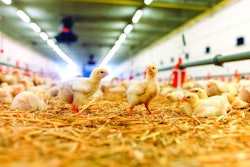
According to recently published Dutch research, health and well-being scores were on average slightly improved for broilers kept in higher welfare production systems, although other factors had a bigger impact than the system.
Furthermore, there was potential to improve welfare under all three systems examined, the research revealed.
In the Netherlands and elsewhere, there is growing pressure from consumers, retailers and other organizations for broiler chickens to be produced under conditions perceived to improve bird welfare. Using slower growing strains, a lower stocking density and environmental enrichment can contribute to better welfare, according to Ingrid de Jong of Wageningen University and Research and others. However, the group wanted to investigate the scale of improvement and any synergies under commercial conditions. Their paper is published in the current issue of Poultry Science.
Overall, the researchers found that the variation in welfare score within each of the three systems examined was greater than that between the three housing and management regimes.
These led de Jong and co-authors to conclude that other factors such as the level of farm management and the quality of day-old chicks can significantly impact the flock’s welfare scores. Furthermore, they report, it is possible to achieve improvements to bird welfare in all production systems.
Three broiler housing systems compared
For their study, the Dutch researchers chose to compare three systems widely used in the Netherlands for producing meat chickens. They described these as a conventional system, a Dutch retail broiler system and the one-star level of the Better Life system. While birds remain housed on a concrete floor with bedding material throughout the production period in the first two of these, the third also allows the chickens outdoor access.
In the conventional system, standard broilers that grow more rapidly are used. Typically, they have a daily growth rate of at least 60g, and are slaughtered at 49 days of age. Under the European Broiler Directive, the maximum stocking density is 42kg per square meter. There is only artificial light, and no environmental enrichment.
Among the differences under the Dutch Retail system is the use of a slower-growing broilers. These have a maximum growth rate of 50g per day, and they are generally reared for 49 days. Housing and management are according to the “Chicken of Tomorrow” requirement. This stipulates a lower stocking rate — 38kg per square meter — than the conventional system. Additionally, environmental enrichment must be provided in the form of one bale of “manipulable material” such as hay or straw per 1,000 birds.
Under the third system investigated in the experiment — Better Life (Beter Leven) from the Dutch Animal Protection Organization — there are requirements for at least 3% natural light in the house, and access to an outside area. Via a series of popholes, broilers can enter a covered outdoor area with mesh sides, which covers 20% of the floor area. Again, the slower-growing strains are used, and the daily growth rate must be no more than 45g per day. Maximum stocking density is 25kg per square meter. As well as a bale of manipulable material per 1,000 birds, each broiler must also be offered 2g of grains daily as environmental enrichment.
How broiler welfare was compared
For their assessment of broiler welfare, the Wageningen researchers employed a total of eight measures.
Five of these were animal-based — mortality, footpad dermatitis, hock burn, breast irritation, and skin damage — and obtained from slaughterhouses and hatcheries. The other three were management-related, and were stocking density, early feeding, and environmental enrichment.
For at least 1,889 flocks of each system in 2017 and 2018, data was collected. For each of the measures, a score of between 0 and 100 was given, with zero being bad, and 100 being the best possible. Overall flock scores were calculated as the sum of these scores.
Overall mean scores were lowest for the conventional system than the Dutch retail, and best was Better Life. However, there was wide variation in scores within each group.
With a maximum of 800 possible, Total Welfare Score (TWS) was in the range 155-532 for the conventional system, 190-586 for the Dutch retail system, and 358-696 for Better Life.
Based only on the animal-based measures, the scores given were 112-488, 113-487, and 151-490, respectively, for each system out of a maximum possible score of 500.
Only parameter for which the conventional system produced the best score was for skin scratches, the researchers noted.
The full paper — entitled “Differences and variation in welfare performance of broiler flocks in three production systems” — by Ingrid de Jong of Wageningen University and Research and others is published in the July 2022 issue of the journal Poultry Science.

















